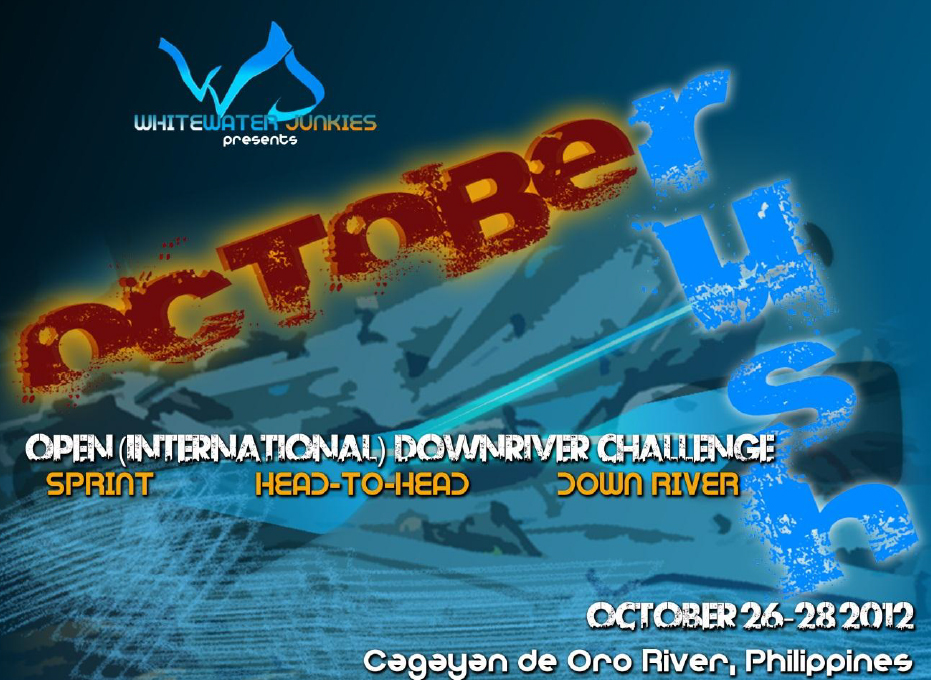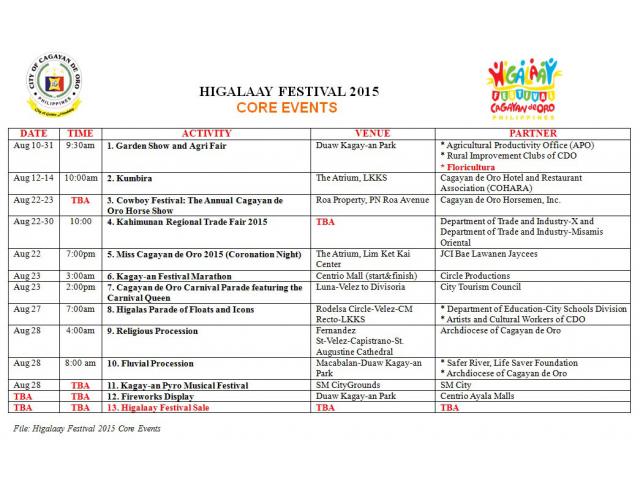Downriver Challenge Present 2012 October Rush
Cagayan de Oro known already the rafting capital of the Philippines, because of white water rafting tourist in Cagayan de Oro are booming. Because of this business in Cagayan de Oro, the Whitewater Junkies in association with CDO Bugsay river rafting create an event and they called it 2012 October Rush. This event would like to invite all outdoors Paddling Sports enthusiasts and other white water rafting outfitters around the country and international neighbouring countries at the 2012 October Rush in the heart of Asia Cagayan de Oro. We already know that aside that this City is really beautiful the people in this city is very friendly, the City has interesting history also that can share and has a world class river for tourist and paddling enthusiasts to paddle. This event will be held on 2 different sections of the river, the put-in of the Lower Section Sprint and Head-to-Head challenge and at the put-in of the Mid-Section down to the put-in of the lower Section of the Down River challenge.
Date and info of 2012 October Rush:
Date: Friday-Sunday October 26-28, 2012
River Location: Cagayan de Oro River, Philippines
Event Organizer: The Whitewater Junkies in association with CDO Bugsay River Rafting
Categories: 6 Paddler team/R6 (Open invitation)
Disciplines: Sprint, Head-to-Head (H2H) and Downriver
Difficulty: Class II to III (Sprint and H2H), Class III to III+ for the downriver depending on the water level.
Rafts: Sotars ST13 classics provided by the organizer.
Rules: Base on international Rafting Federation (IRF) rules.
Entry Fee: 500php/paddler or 3000php/team plus 1 reserved.
Other Fees: 500php for brand/team sponsors. (Read the mechanics below)
Accommodations: A list of accredited hotels at the city will be provided. Check Facebook Page http://www.facebook.com/TheWhitewaterJunkies. Check CDO Hotels list.
Transport: Will provide transportation from hotel to venue and vice versa.
Registration: contact Marc Nicholas Alo at 09177044112 or marnduchess@yahoo.com for pre registration and for official registration it will announce of Facebook Page.
Race Course: There will be a familiarization tour prior to the race days. The sprint and Head-to-Head challenge will be held at the put-in of the power section of Cagayan de Oro River passing through 2 major rapids of class II and III. The down river challenge will be held at the put-in of Middle Section down to the put-in of the lower section passing through 9 major rapids of class II and III. Recycling of boats will be easy since there is a road access of going back to the put-in. (Please read the Mechanics)
Number of Teams accepted: 16 and up totals
Schedule: Final schedule will be announce on Facebook Page.
Mechanics and Rules for 2012 October Rush: Please read carefully
Race Mechanics
A. Race Format
1. General:
a. All competitors must be 18 years old and above.
b. All competitors must be physically fit.
c. This rafting competition consists of 3 disciplines: – Sprint, Head to Head (H2H), and Down River race.
d. The start and finish line is marked clearly with a line across the river or with buoys or poles on the left and right sides. The race director has a right to change that start position due to unusual circumstances (e.g. changes in water level, obstructions, etc.).
e. All teams will have a chance to do a familiarization run on given days (shown below) before the race at their own expense. October 22-25, 2012.
2. Sprint
a. The first discipline of the competition.
b. The starting order of the sprint has to be drawn out of a hat.
3. Head-to-head (H2H)
a. Teams race in pairs, head to head in a knock out format. It is recommended that the H2H immediately follow the Sprint.
b. All teams qualify for the H2H, nevertheless only a limited number of teams proceed to the stage two of the competition. Based on results of the sprint some teams proceed directly to the stage two and other teams have to compete in the stage one in order to proceed further. The race order is specified in respective “H2H Race Order Form” (see the form/forms).
*Details will be explained during the Captain’s Meeting.
c. In the Stage 1 and the first round of the Stage 2 the team with the faster time in the Sprint has lane choice. Thereafter the team with the faster time in the previous round has lane choice.
d. The winners of the semi-finals race in the A final to determine first and second positions. The losers of the semi-finals race in the B final to determine third and forth positions. The final position of all other teams is determined by their ranking against the other teams knocked out in the same round using their time from that round. For example, the 4 teams knocked out in the quarter finals are ranked by their times in that round and based on their ranking take the positions 5th to 8th.
e. Teams late for their start may forfeit their run.
4. Downriver race
a. The down river race is the most demanding of all disciplines and therefore highest ranked in the point system.
b. The total duration of a down river race is between 20 to 40 minutes depending on the rapids and access to the river.
c. The race should be started in groups of 4 rafts per heat. However, if the possibility exists for more than 4 rafts to start simultaneously then this figure should be chosen.
d. Groupings of teams per heat are based on their rank from total previous achieved points.
**Details will be explained during the Captain’s Meeting.
e. The start line should be as fair as possible for every team but due to river conditions this is often impossible. Therefore teams will be allowed to select their starting position in order from highest ranked to lowest ranked according to the total previous achieved points.
***Details will be explained during the Captain’s Meeting.
f. Teams late for the start may forfeit the race.
B. General Competition rules
1. Flips are no reason for disqualification as long as the raft has been re-flipped and all team members are inside the raft when crossing the finish line. Failing to have the raft re-flipped and all team members inside the raft (feet outside the water) when crossing the finish line results in a 50 second time penalty.
2. No intentional contact between paddle to paddle, person to person, person to paddle/raft is allowed at any stage of a race. Time penalty per infringement: 10 seconds. Ramming is allowed.
3. Intentional blocking of teams wishing to pass is illegal. Intentional blocking is defined as the intentional changing of direction more than once intended with the aim of impeding the progress of another raft. Time penalty per infringement: 10 seconds.
4. In the event of a team member being unable to continue due to injury, the team may only continue once the injured party has been handed over to the satisfaction of the safety/medical personnel.
5. Outside assistance (by persons other than team members) is prohibited during the race with the exception of dangerous situations. The penalty for this is disqualification from the run.
6. After runs, teams must assist the operations personnel in carrying rafts back to the start or loading the jeep for transport. Arrangements will be stated at the previous captain’s meeting.
7. Captain’s Meetings:
a. The first Captain’s meeting must be held the night before the first official day of the event. The event program/schedule is to be provided to all team Captain’s at that time.
b. Subsequent meetings should be held the day prior to each competitive discipline
c. Written minutes are to be provided to all the captains at the end of the meeting if there is any deviation from the rules or within an hour where possible.
d. Only Captain’s and, where needed, their interpreter’s are allowed into the captain’s meetings.
Exceptions are to be applied for to the Race Director.
e. Captains are to sign off on the meetings minutes and race rules in case minutes are provided as
per art. B7 c).
8. In every event the timing starts when the starter gives the command go and the pre-starter(s) simultaneously release the raft(s) or when first part of raft crosses the starting line. Where the start is not measured electronically, the starter can ask for paddles to be off the water until he gives the command “Go”.
9. The timing stops when any part of the raft first crosses the imaginary finish line. All members of the team must be inside the raft otherwise a 50 second time penalty will be given.
10. A time penalty (50 seconds) will be given to any team trying to cheat the start signal. If a false start occurs the start must be repeated. Any team that receives a second warning is automatically disqualified from the discipline. The vacant starting position will not be filled by another team.
11. In a case where there is a tie in points and time, teams are to select their starting positions by drawing it from a hat or flipping of a coin. If teams are tied for positions in the Downriver, if possible they are to be kept in the same group where possible.
12. At the end of the competition, in the unlikely event of two teams having equal points overall, the winner of the Down river is to be given first place.
13. Section marshal are to be provided with an isolated or roped-off area and competitors can be penalized for not moving out of this area when requested to do so by any Marshall.
14. If a team doesn’t finish a race, that team gets no points for the race.
C. Scoring System
1. Teams are awarded points in each discipline according to their finishing position.
2. The maximum points awarded are:
Sprint 150
H2H 350
Down River Race 500
Total 1000
3. The points awarded to each team are calculated as a percentage of the maximum points available as follows:
1st place – 100%, 2nd place – 88%, 3rd place – 79%, 4th place – 72% 5th to 18th place – less 3% each place, 19th to 32nd place – less 2% for each place. (32nd place will therefore receive 2% of points.)
4. A team that does not start a race at all will receive 0 points
5. The overall results are determined by ranking teams according to the total points achieved during the competition.
D. Rafts and equipment
1. Rafts used in this competition are provided by the organizers. (SOTAR ST 13’ classics)
2. All rafts are provided with a safety line around the outside and a bow line in front.
3. Any other ropes and rigging are, for safety reasons, strictly prohibited.
4. Every competitor is free to use his/her own personal floating device (PFD) and single blade C1 paddle. Oars are banned.
5. Anyone found tampering with a raft will receive at least a time penalty on their team’s next discipline. The time penalty will be decided by the Race Officials and will be in accordance to the severity of the tampering and the time length of the next discipline. Tampering entails but is not limited to inflating the rafts above the specified pressure, blocking valves and changing the raft in any way to give the team an advantage.
E. Bibs and flags
a. Every competitor must wear a race bib over the PFD’s provided by the organizers during each race. The back side and the front side are reserved for event sponsor logos only.
b. Each team member is fully responsible for his/her bib.
c. No official race bib no race.
F. Safety at/on the river
1. Every competitor must use his/her own personal safety equipment during the entire event at all times on the water. (PFD’s, helmet, paddle)
2. It is compulsory for all disciplines on natural rivers that at least one team member carry a flip line, a river knife (optional) and a throw bag. Throw bag must be stored safely and be minimum of 15m long if not specified prior the race. River knife should be accessible with one hand. On artificial courses safety equipment is defined by the Safety Director. Information about the minimum Safety equipment must be communicated by the organizers together with the clothing requirements including also the required length of throw bag.
3. Prior to the start of the first race, the safety director or a delegated member of the safety team may check the safety equipment. The race director or a delegated starter can do the same too. Any team not complying with the safety requirements will not be allowed to continue until the safety requirements are met. A team’s run may be forfeited if they do not satisfy the safety requirements by their allocated start time.
4. The safety director has the right to stop the competition immediately if any hazards to the competitors and/or officials arise. No Race discipline starts without the confirmation of the Safety Director.
5. In safety issues the safety team has the final say. All teams/competitors must follow the orders of the safety personnel. If they require a raft to stop or help with a situation, they will give a specified signal and this must be obeyed. This signal will be notified at the captain’s meeting prior to that event. Any team ignoring race or safety officials or showing disregard for their own or other’s safety may be penalized and/or disqualified from the event.
6. In any event competitors take part at their own risk. Neither the Whitewater Junkies, sponsors nor organizers bear responsibility for accidents or damage that may occur during a competition. Every participant, including organizing staff and competitors, is obliged to act in a safety conscious manner at all times so as to minimize the risk of an accident or damage.
7. It is the competitors’ responsibility to act in a safety conscious manner minding their own, their team’s and others’ safety. Competitors must mind their own outfit, their position and set up in the raft (for instance eliminating potential dangers around them such as sharp edges, loose ropes, loops, open carabineers, etc.) The Safety Director is entitled to require adjustments on teams outfit and set up. Competitors are responsible for all their actions on the shore and on the water regarding safety. Violation against this rule may cause penalties up to disqualification.
8. The Race Director and Safety Director have the right to change the above stated rules where it is deemed necessary for improved safety, but this must be announced in advance.
G. Officials and duties of officials
1. Head of the organizing committee / Event Director:
a. He/she is responsible for the overall running of the competition and coordinating all local preparations.
b. His/her responsibilities include entries, dealings with local authorities, staff, safety team, media releases, technical and raft equipment, prize giving, and lodging of the officials and competitors.
2. Race Director
a. He/she runs the races according to the race rules together with the Race Officials.
3. Safety Director
a. He/she is in charge of safety during the competition.
b. He/she is able to call for an immediate stop to the competition if he/she considers that any dangerous or potentially dangerous situation arises or the river level reaches a pre-determined cut off level.
c. He/she together with the organizing committee is responsible for the delivery of the Risk Assessment and the Safety & Rescue Plan.
d. He/she has the right to check self-rescue abilities of any member of any participating teams and exclude those not complying with minimum expectations that are defined and can be reviewed in the Race Rules document.
e. He/She together with the Race Director has the right to change the Start and Finish positions due to safety reasons.
f. The Safety Director reports to the Race Director.
4. Chief starter
a. He/she ensures that the teams are in the correct racing order and gives permission to start.
b. He/she will be assisted by another starter/pre-starter for each additional raft to ensure that the start is as fair as possible and to prevent a false start. Rafts are always held from the stern at the start, preferably by the outside line/rear handle or a loose end rope.
c. He/she can refuse to start a team if the team or a single team member fails to respect the safety rules, is late for the start, is not wearing the issued bib(s), or does not follow the starter’s orders.
d. In the event of a false start, he/she will stop the race immediately and give the team responsible an official warning. In the case of a second false start caused by the same team he/she must disqualify the team from this particular race.
e. He/she announces a countdown to the teams at the start according to the start interval: 5 minutes,“1 minute, 30 sec., 20 sec., 10 sec., paddles out of the water” (at 5 seconds before start). At “0” the starting signal is to be made. The signal should be loud and clear.
5. Section Marshall
a. He/she is in charge of a section of the river.
b. All section marshals must be approved by the organizing committee. The section marshal will transmit the penalties to the race director as soon as possible by radio, phone or running personnel.
c. If a section marshal sees evident discrepancy in judging, they can overrule immediately.
6. Finish judge
a. He/she determines when the teams have crossed the finish line and in what order and coordinates with the chief starter. He/she will be assisted by and work closely with the time keepers.
7. Time keeper
a. He/she is responsible for keeping the exact time and transmitting this to the race director.
b. A separate back up timing must be in place in case the official timing fails.
H. Protest
1. In the sprint, H2H and down river race protests must be lodged by the team captain to the Finish Judge within 5 minutes of completion of the run or race.
2. Protests are to be made in writing on the forms available from the Finish Judge or Jury Member.
3. Protests are to be heard in a secluded area in which only the jury and the team captain (or team member making the complaint) will be. This enclosed area should have technical facilities to view video or other relevant material if possible.
4. The protest fee is Php 1,000.00 and must be paid as a deposit with the written protest. No cash, no protest!
5. Video/TV evidence is legal.
6. If the protest is successful the money will be returned.
I. Prize giving and awards
1. Titles are awarded for each discipline and overall.
2. The overall prize giving will be held together with the prize giving for the last race.
3. Prize giving events may be arranged in accordance with the requirements of the main sponsor. The decision will be made by the organizers.
4. Tokens for all competitors and trophies for the winners.
5. All team members must be called to the podium.
6. All team athletes must either wear their team uniforms. Paddles are allowed to be carried on to the podium.
J. Invitations, entries and confirmations
1. An entry must contain the name of the sponsor or team name, first and last name for each competitor, team captain, other personnel and contain all information required as set-out in the invitation.
2. Team registration:
a.) Registration per team is three thousand pesos (Php 3000). Any team who uses/advertises the name of a company/product during the event shall have an additional payment of five thousand pesos (Php 5000) on top of the registration fee.
b.) However, local rafting companies may freely use their name without additional cost.
c.) All personal equipment’s may be branded except for the paddle boat/raft itself.
d.) Deadline for the registration fee is on or before October 19, 2012. Registrants after the said date will no longer be entertained as to avoid any delays (for prompt compliance).
3. Entries can be made by e-mail (marnduchess@yahoo.com) or by phone (+63917-7044112) before the deadline.
4. The organizing committee must confirm each entry within one week of receipt by e-mail or by phone.
5. Entry fees for the event are to be made no later than the date specified by the organizers. Any late payments can result in the team being excluded, unless specific arrangements have been made in writing with the organizers.
6. Announcement of any changes must be made or confirmed during the first Captain’s meeting.
7. The start list and any other relevant information must be handed to the teams no later than the first Captain’s meeting.









